

Damion Smy
Suzuki Fronx recalled after seatbelt failure sparks ‘urgent investigation’
7 Hours Ago
The Volkswagen ID. Buzz Cargo melds head-turning design with neck-snapping performance, making it Australia's most charismatic delivery van.



Contributor

Contributor


Contributor

Contributor
Where expert car reviews meet expert car buying – CarExpert gives you trusted advice, personalised service and real savings on your next new car.
Almost three years after its reveal in production form, and nearly eight years after it was previewed in concept form, the Volkswagen ID. Buzz people mover and van range has finally arrived in Australia.

Local customer deliveries of the first battery-electric vehicle (EV) to be sold by Volkswagen in Australia, following numerous delays and setbacks to the ID.4 and ID.5 mid-sized electric SUVs, are set to commence late this year into early next year.
We reviewed the ID. Buzz people movers for the first time on home turf earlier this week, but the ID. Buzz Cargo commercial van forms the entry to the range, priced at $79,990 before on-road costs. It goes up against the likes of the LDV eDeliver 7 and Mercedes-Benz eVito, and the Ford E-Transit Custom when it arrives in 2025.
This big German delivery van is based on the Volkswagen Group’s dedicated-electric MEB platform, which also underpins both the Volkswagen ID.4 and ID.5, as well as the VW ID.7, the Cupra Born and Tavascan, the Skoda Enyaq and Elroq, and Audi Q4 e-tron, among other EVs.
WATCH: Paul’s video review of the ID. Buzz Pro SWB
Since the reincarnated Kombi van was revealed back in 2022 with electric power, it has been upgraded with a more powerful electric motor and a larger touchscreen infotainment system, among other minor tweaks.
Is this electric van just a cute design exercise that exploits the heritage of the Kombi, or is it the real deal? Read on to find out.
The Cargo van is the most affordable variant in the battery-electric ID. Buzz range, and it’s available in just one high-spec, short-wheelbase rear-wheel drive BEV550 Pro variant.

At about $80k plus on-road costs, it easily undercuts the two people mover variants (the BEV560 Pro SWB RWD at $87,990, and the BEV560 Pro LWB RWD at $91,290, before on-roads respectively). It’s also cheaper than the eVito LWB (from $98,951), but more expensive than the LDV eDeliver 7 (from $67,358).
The second iconic VW model to be reincarnated, following the now-discontinued Beetle, will be joined next year by the flagship GTX LWB AWD ($109,990 plus on-roads).
| Model | Price before on-road costs |
|---|---|
| 2025 Volkswagen ID. Buzz Pro Cargo SWB BEV550 RWD | $79,990 |
To see how the Volkswagen ID. Buzz stacks up against its rivals, use our comparison tool
Buy your new car without the stress. It's fast, simple and completely free.

Great service from Travis and team, second time I have used this business would not hesitate to recommend them to anyone
Craig C.
Purchased a Ford Ranger in Sunshine Coast, QLD
CarExpert helped Craig save thousands on his Ford Ranger, now let us save you on your next new car.
Find a dealAs you’d expect of a reinvented electric Kombi van, the ID. Buzz Cargo is pretty modern and futuristic inside. Commercial vans typically stick with tried-and-tested designs, so this is a drastic change.

It’s easy hopping into this electric van due to large front doors that open nice and wide, and a ride height that makes it a natural step up into the cabin. One of the few things that is missing is a grab handle on the A-pillar.
Once inside, the seats are typical van fare. At launch, there’s only a three-seat bench option with a driver’s seat that offers manual adjustment, and a two-person passenger seat that’s a one-piece unit and fixed in place.
The driver’s seat is comfortable enough and offers adequate support for longer drives. This makes sense because a lot of ID. Buzz Cargo owners will spend a considerable amount of time behind the wheel.
The two-person bench seat on the passenger side, however, is a considerable step down in comfort. You can’t even adjust the backrest angle and it feels like you’re sitting at a 90-degree angle. And two people on the bench seat is rather squishy in terms of space.
It would be nice if Volkswagen considered introducing a two-seat option because although it doesn’t offer the same seating capacity, your passenger will be much more comfy and likely less grumpy when you get to the work site.
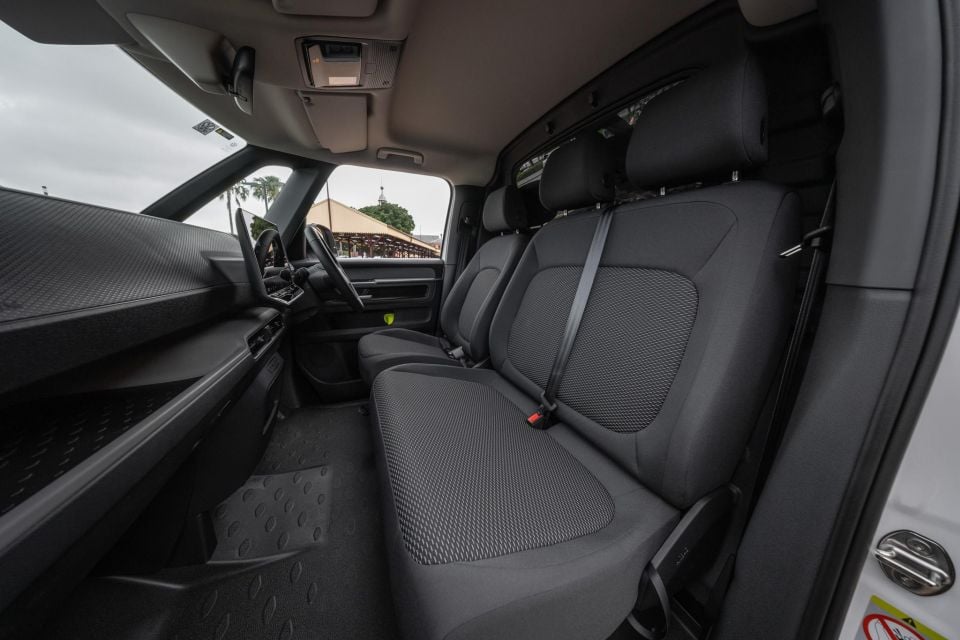
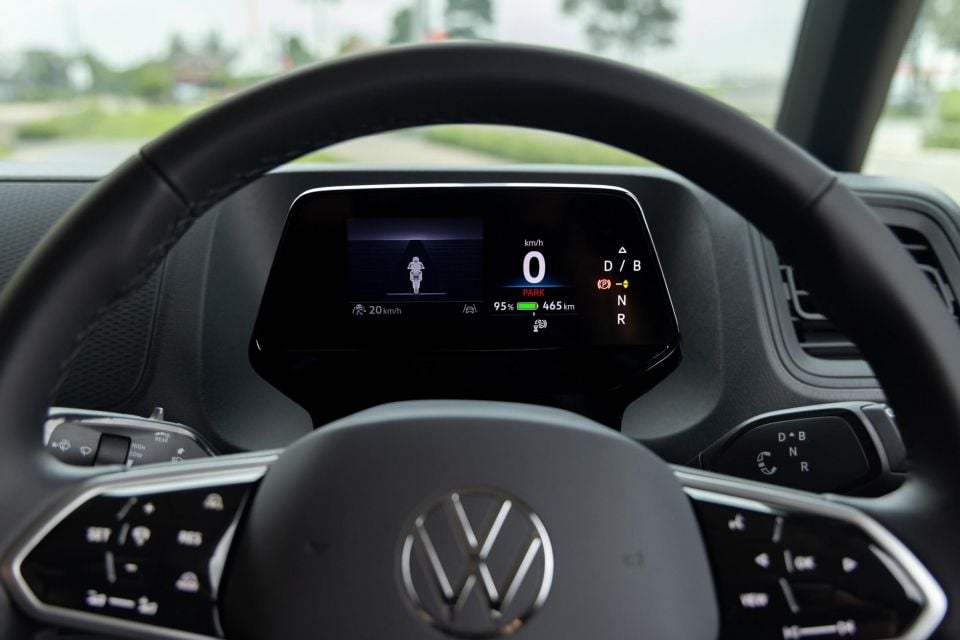
Ahead of the driver is a lovely leather-wrapped steering wheel that’s a surprising standard inclusion in a workhorse-oriented commercial van. It offers a great amount of tilt and reach adjustment, meaning plenty of people will be able to get comfortable behind the wheel.
One downside, however, is the steering wheel is fitted with Volkswagen’s annoying touch-sensitive buttons. This is somewhat excusable in the regular ID. Buzz people mover, but it’s frustrating in a commercial vehicle because they get grimy quickly.
It would be nice if the ID. Buzz Cargo came with proper physical steering wheel buttons like all the other models in the Volkswagen Commercial Vehicles range. Even the German carmaker’s passenger range is re-adopting these.
Behind the steering wheel is a small digital instrument cluster, as in other Volkswagen ID. models. Despite its size, it shows all the critical information you need to see while driving, and there’s a small amount of custom configuration available to make it more personalised.
Moving across to the centre, there’s a 12.9-inch touchscreen infotainment system that’s properly large, bright and high-resolution. It’s easy to move around the different menus, and if you do get lost there are shortcut buttons that are always present at the top of the screen to make life easier.
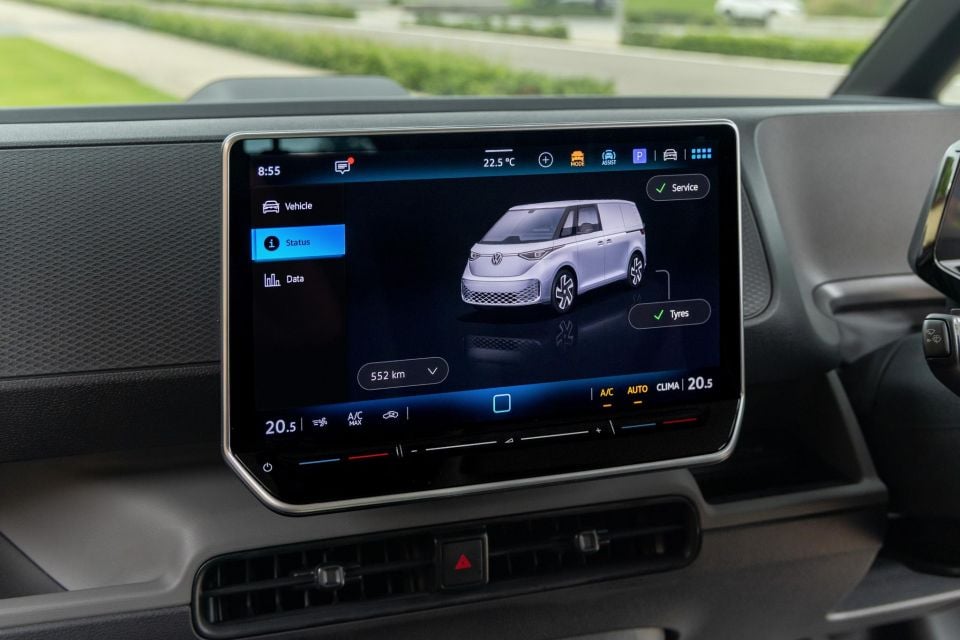
It’s occasionally a little frustrating that you need to use the touchscreen to adjust some of the climate control functions, but like the shortcut buttons there’s a range of key features always present at the bottom of the screen. There’s also a physical touch slider under the touchscreen for adjusting the cabin temperature.
If you don’t like using the touchscreen, however, you can interact with the IDA voice assistant. It’s able to change the climate control, among many other functions – including telling you a joke.
Another minor frustration at the launch was that our test vehicles were only equipped with wired Apple CarPlay and Android Auto. Wireless forms of both phone mirroring systems will be available as part of an over-the-air update in the first quarter of 2025.
That meant we needed to physically plug our phone in using a USB-C cable to use smartphone mirroring. Thankfully, the connection was rock-solid and didn’t waver at any point.
Looking around the cabin, the ID. Buzz Cargo is clearly a commercial vehicle. There are even more harder plastics, if that’s possible, than the people mover.
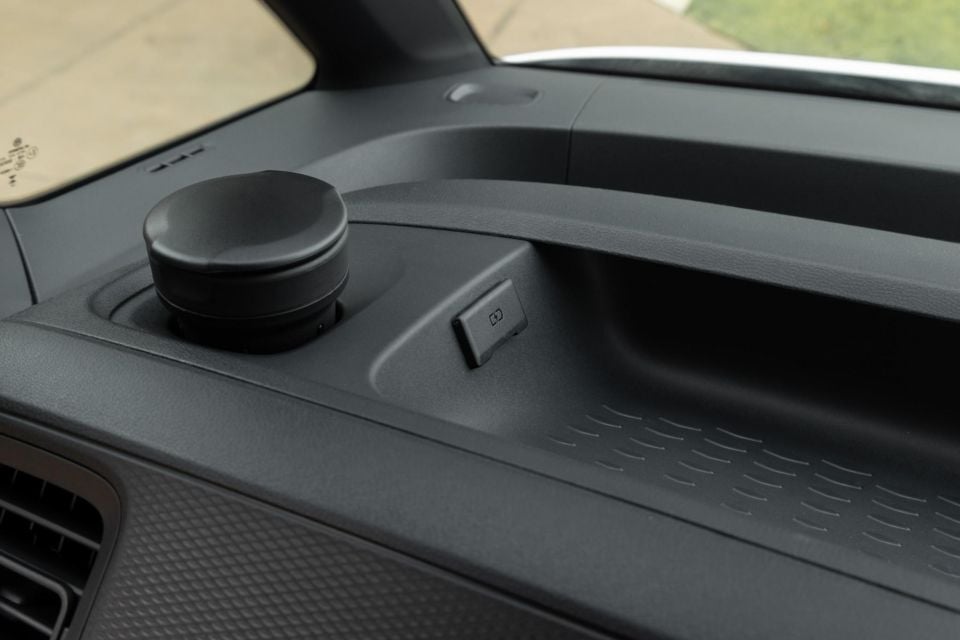

The door armrests are hard and the flooring is plastic, plus all the interior finishes are boring black, which is far from uncommon in the commercial van space.
Unsurprisingly, there’s a wealth of storage around the cabin, including vast spaces on the dashboard. There’s even a load-through hatch that allows you to extend items from the cargo area into the cabin. It gives you an additional 450mm of load length.
As standard, the ID. Buzz Cargo comes with power-latching side sliding doors and a rear tailgate. You can option power sliding doors, and a power tailgate. Barn doors are also on option.
The load space measures 2208mm long, 1732mm wide (1230mm between the wheel arches), and 1257mm tall. All up there’s 3.9 cubic metres of space.
Volkswagen claims the ID. Buzz Cargo’s load area is large enough to hold two Euro pallets. In terms of amenities there are tie-down points, fastening rails, illumination, a partition between the cabin and load space with a window, and other handy details.

| Dimensions | ID. Buzz Cargo |
|---|---|
| Length | 4712mm |
| Width | 1985mm |
| Height | 1927mm |
| Wheelbase | 2989mm |
| Cargo capacity | 3.9m |
To see how the Volkswagen ID. Buzz stacks up against its rivals, use our comparison tool
The Volkswagen ID. Buzz Cargo has the same electric motor and battery configuration as the ID. Buzz Pro SWB five-seat people mover.

| Specifications | Volkswagen ID. Buzz Cargo |
|---|---|
| Drivetrain | Single electric motor |
| Battery | 79kWh li-ion |
| Power | 210kW |
| Torque | 550Nm |
| Drive type | RWD |
| Weight (kerb) | 2374kg |
| Energy consumption (claimed) | 20.3kWh/100km |
| Energy consumption (as tested) | 19.4kWh/100km (100km) |
| Claimed range | 431km |
| Max AC charge rate | 11kW |
| Max DC charge rate | 185kW |
| Payload | 774kg |
| Gross vehicle mass (GVM) | 3150kg |
| Braked towing capacity | 1200kg |
To see how the Volkswagen ID. Buzz stacks up against its rivals, use our comparison tool
Like all Volkswagen Group EVs, you don’t need to actually start up the ID. Buzz Cargo. Instead, all you need to do is hop in, buckle your seatbelt, and press the brake pedal.

When this happens the car will switch on, and all you need to do to get moving is twist the user-friendly column-mounted gear selector to either drive or reverse.
Setting off, this large boxy commercial van is incredibly zippy. Its rear-mounted electric motor offers all 550Nm of torque from standstill, so it’s not underdone in terms of low-speed performance in any regard.
In fact, the ID. Buzz Cargo feels almost performance-car quick at low speeds and around town, which feels incredibly unusual in a commercial van. This makes it confidence-inspiring when you need to set off from the lights, or accelerate with a heavy load onboard.
This big electric van isn’t all about straight-line speed, however. The rear-wheel dynamism gives it a lot of character and actually make it fun to toss around in city streets.
There are two ways to drive the ID. Buzz Cargo. In ‘D’ it drives just like a regular combustion-powered vehicle, requiring you to press the brake pedal to slow down.

But in ‘B’ mode, which is activated by twisting the gear selector to ‘D’ once more, the regenerative braking ramps up when you lift off the accelerator, proving a convenient level of ‘engine braking’. While this was my preferred way to drive this car, there’s no full one-pedal drive mode since you still have to hit the brake pedal to come to a complete stop.
The ID. Buzz Cargo comes with rear drum brakes as standard, which perhaps isn’t surprising given EVs rely a lot more on regenerative braking. But the transition from regenerative braking to regular friction braking can be a little disjointed.
Complementing this car’s zippy rear-mounted electric motor is the well-weighted steering. It’s not too light nor too heavy – Goldilocks would approve.
At low speeds the ID. Buzz Cargo is almost completely silent, and the suspension does a good job of minimising harsh road imperfections. Even opting for the larger 19-inch alloy wheels doesn’t ruin the low-speed ride.
Although this electric van may feel hot-hatch quick around town, there’s no getting around its size when it comes to parking. At just over 4.7 metres long and almost 2.0-metres wide, it’s a big car that fills a parking space.


Thankfully there are front and rear parking sensors as standard, though unlike the people mover there’s only a reversing camera so fortunately it has decent resolution.
Outward visibility isn’t great, but this is pretty common for vans. As standard, there’s a rear window but the centre head restraint blocks your view. And if you opt for the barn doors there’s no rear window at all. Thankfully side visibility is pretty good and the side mirrors are decently sized.
During our media launch, we had the opportunity to briefly drive an ID. Buzz Cargo loaded up with 500kg, which is close to its 774kg payload figure, but only around town at low speeds on Newcastle streets.
While the electric van certainly felt like it had a heavy load on board because it leaned considerably in corners, it didn’t noticeably affect performance. In this regard there’s a light-and-day difference between the ID. Buzz Cargo and the Peugeot E-Expert, which only makes do with a 100kW front-mounted electric motor.
One of the main differences to other EVs in terms of driving is you need to rely on the brakes more, as the regenerative braking system isn’t quite strong enough. The brake pedal feels a little squishy, which is a common trait in vehicles with rear drum brakes instead of discs all around.

The ride while loaded up was surprisingly plush, soaking up pretty much every road imperfection. You can tell this is built to have a heavy load on board. Even harsher speed bumps didn’t faze the ID. Buzz Cargo, though you’d want to make sure your cargo is tied down tight.
Out on the open road the rear-mounted electric motor doesn’t run out of puff. It maintains highway speeds really well and even feels like it has plenty left in the tank for overtaking. This is somewhat surprising, given the brick-shaped silhouette.
It’s not perfect, however, as it can get tossed about a bit in the wind. But the Cargo’s interior doesn’t have nearly as much road noise as its people mover counterpart, thanks to its partition between the cabin and load areas. You can easily have a conversation with your passengers without having to raise your voice.
While the high-speed ride quality of the ID. Buzz people mover with optional 21-inch alloy wheels can be a little rough and unsettled, with smaller 18- and 19-inch wheels the ID. Buzz Cargo is considerably more compliant thanks to the extra sidewall.
On the safety front, the ID. Buzz Cargo is pretty much as fully loaded as the people mover version. The adaptive cruise control is great, like it is in many Volkswagen vehicles, though the undertaking prevention feature does grate.
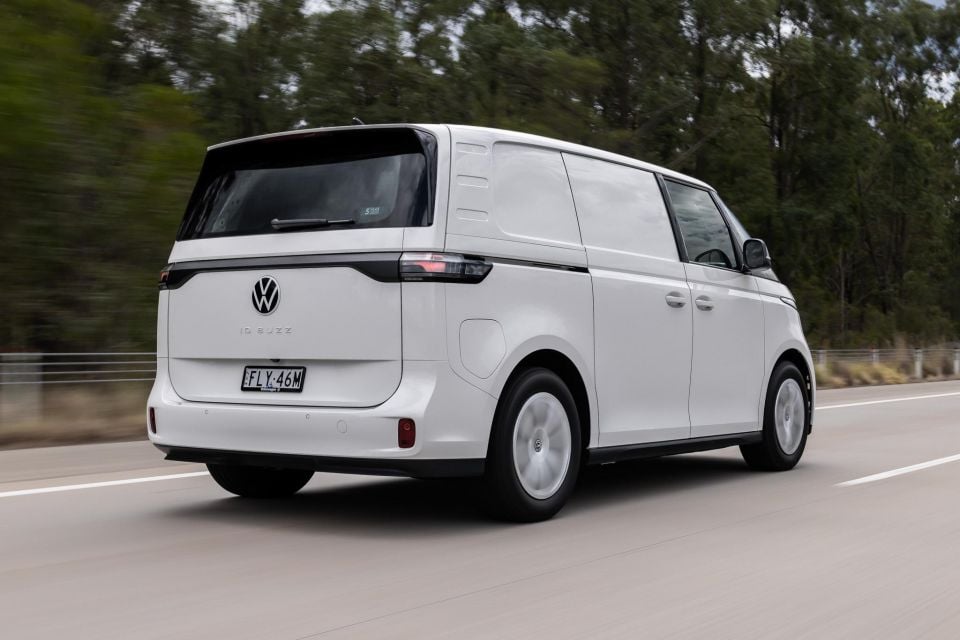
Where expert car reviews meet expert car buying – CarExpert gives you trusted advice, personalised service and real savings on your next new car.
The Travel Assist function that combines adaptive cruise control and lane centring is a fantastic companion on long highway drives as it reduces driving fatigue. It doesn’t pull at the steering wheel too hard, though on poorly marked roads it can get a little lost.
Lastly, the ID. Buzz Cargo comes with bright LED headlights as standard, though you can option more sophisticated Matrix LED headlights. These are a great feature for dimly lit rural roads, where it allows you to have the high-beams on all the time and will dip only part of the beam when it detects other tail-lights or oncoming headlights.
To see how the Volkswagen ID. Buzz stacks up against its rivals, use our comparison tool
Only one variant of the ID. Buzz Cargo is available from launch.




Volkswagen ID. Buzz Cargo equipment highlights:
To see how the Volkswagen ID. Buzz stacks up against its rivals, use our comparison tool
Like many commercial vehicles, the ID. Buzz is available with a wide variety of optional equipment.

Exterior Upgrade Package – Tailgate ($3480) adds:
Exterior Upgrade Package – Rear Wing Doors ($2980) adds:
Other standalone optional equipment includes:
To see how the Volkswagen ID. Buzz stacks up against its rivals, use our comparison tool
Candy White solid paint is the only standard exterior finish.

Metallic and pearlescent finishes cost an extra $1890. These comprise:
To see how the Volkswagen ID. Buzz stacks up against its rivals, use our comparison tool
The Volkswagen ID. Buzz has attracted a five-star safety rating from Euro NCAP based on testing conducted in 2022, but Australian sister authority ANCAP has yet to apply a rating locally.
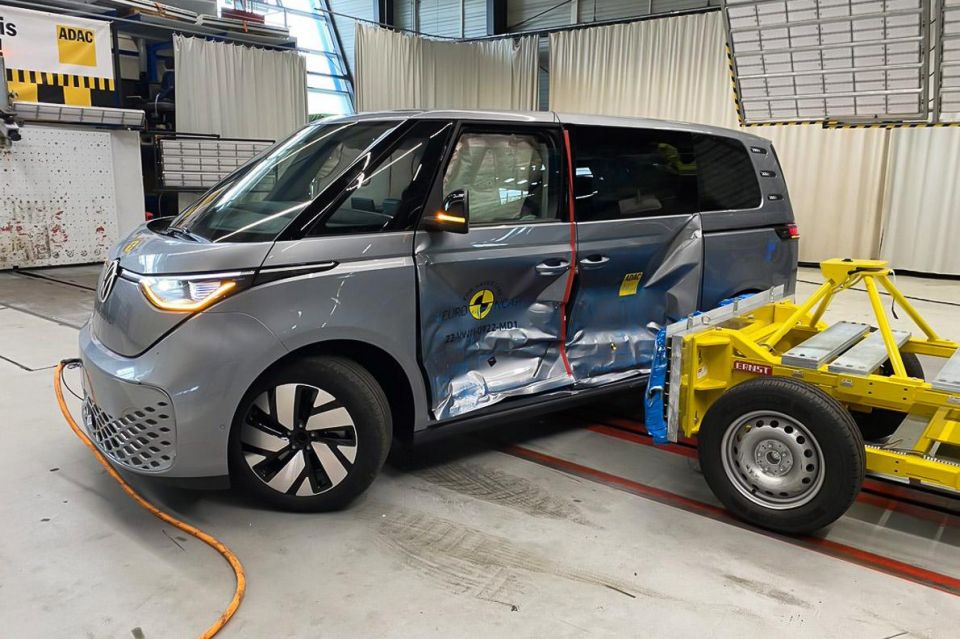
Standard safety equipment includes:
All Volkswagen ID. Buzz owners receive a complimentary five-year subscription to a third-party connected services system called Goconnect.
Via the Goconnect phone app, owners can view their parking position, visualise the vehicle’s most recent trips, interact and book appointments with their dealer, view important errors and warnings, check the high-voltage battery status, and more.
To see how the Volkswagen ID. Buzz stacks up against its rivals, use our comparison tool
The Volkswagen ID. Buzz is covered by a five-year, unlimited-kilometre warranty, though the high-voltage battery is covered for eight years or 160,000km, whichever comes first.

| Servicing and Warranty | Volkswagen ID. Buzz |
|---|---|
| Warranty | 5 years/unlimited kilometres 8 years/160,000km (HV battery) |
| Roadside assistance | 2 years |
| Service intervals | 24 months/30,000km |
| Capped-price servicing | Up to 10 years |
| Total capped-price service cost | $1450 (6 years) $1850 (8 years) $2250 (10 years) |
Coinciding with the launch of the ID. Buzz, Volkswagen Group Australia has detailed its new ‘peace of mind’ package for all of its existing and new EV customers.
Highlights include guaranteed future value, novated leasing options, “all in one” weekly repayments, roadside assist, eight-year/160,000km battery warranty, battery health checks, EV loan cars, and more.
ID. Buzz owners in particular will get discounts at Ampol’s AmpCharge public charging network, as well as discounts on a range of home chargers.
To see how the Volkswagen ID. Buzz stacks up against its rivals, use our comparison tool
If you’re in the market for a delivery van that stands out from the crowd without even having to put signage on it, look no further than this.

During our drive in Newcastle so many people craned their necks just to get a glimpse of this bizarre retro-yet-modern looking box on wheels. It’s very fitting for born-again Kombi van, though I do wish the ID. Buzz Cargo was available with two-tone paint options like the people mover.
In terms of driving dynamics, this is the most engaging van I’ve experienced to date. A lot of European vans verge on feeling almost car-like behind the wheel, but this rear-wheel drive electric van takes it to another level. Its relatively high-output e-motor makes it very zippy, yet it’s also nowhere near as power-hungry as I expected.
I’d go as far to say the ID. Buzz Cargo is my pick out of the entire ID. Buzz range. The cabin so much quieter thanks to the partition between the passenger and cargo spaces, plus the climate control doesn’t have to work as hard to heat/cool the vehicle.

It’s not perfect though. Like many commercial vehicles, hard plastics and finishes abound up front. I’m also not the hugest fan of the black-on-black-on-black interior colourway, especially in a vehicle that’s so loud and characterful on the outside.
Then there’s the price. At $79,990 before on-roads it’s not cheap compared to its most direct competitors, but for a company, fleet buyer or individuals via a novated lease, the ID. Buzz Cargo can actually stack up as good value – as long as you don’t go crazy on the options and you have the ability to charge it at work or home.
Notwithstanding its high price tag, this is the coolest van I’ve ever experienced.

Interested in buying a Volkswagen ID. Buzz? Get in touch with one of CarExpert’s trusted dealers here
Click the images for the full gallery
Where expert car reviews meet expert car buying – CarExpert gives you trusted advice, personalised service and real savings on your next new car.
Jack Quick is an automotive journalist based in Melbourne. Jack studied journalism and photography at Deakin University in Burwood, and previously represented the university in dance nationally. In his spare time, he loves to pump Charli XCX and play a bit of Grand Theft Auto. He’s also the proud owner of a blue, manual 2020 Suzuki Jimny.


Damion Smy
7 Hours Ago


Damion Smy
8 Hours Ago


Damion Smy
9 Hours Ago


Damion Smy
12 Hours Ago


CarExpert.com.au
13 Hours Ago


Ben Zachariah
15 Hours Ago